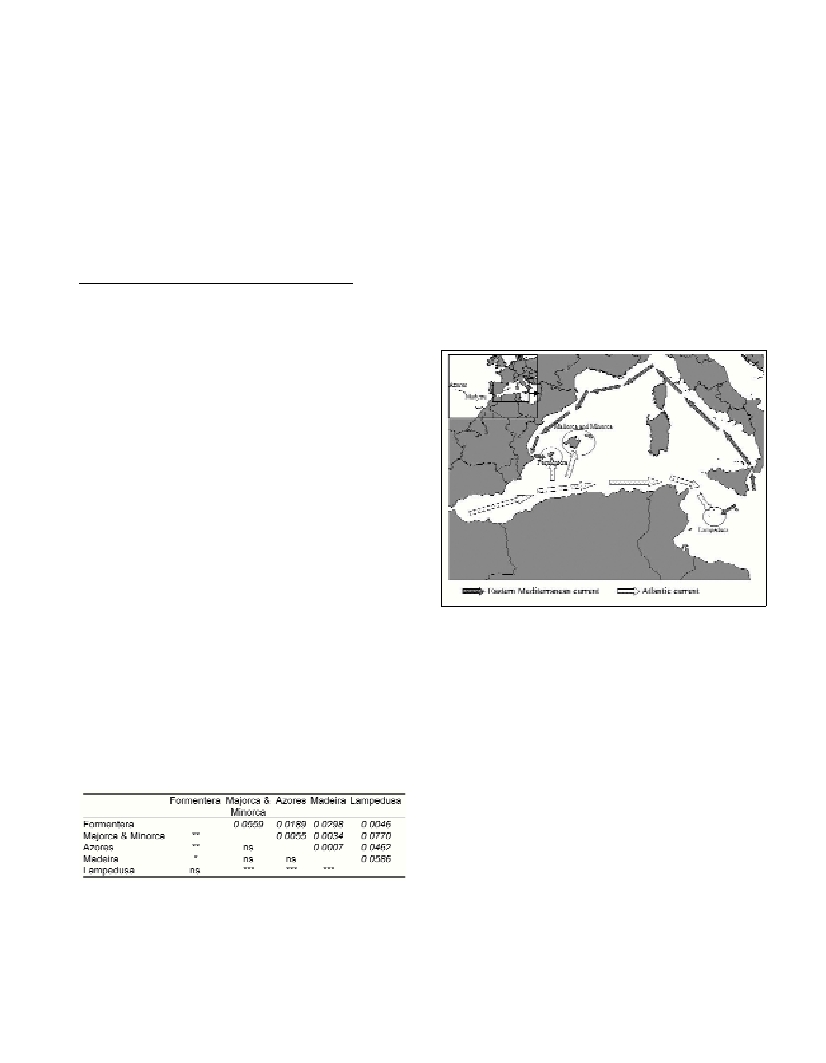ORIGIN AND MIGRATION PATTERN OF THE LOGGERHEAD TURTLE
IN THE WESTERN MEDITERRANEAN
Carreras C.
1 *
, Pascual M.
2
, Cardona L.
1
, Fernández G.
3
, San Félix M.
4
, Aguilar A.
1
1
Department of Animal Biology, Faculty of Biology, University of Barcelona, Spain - * carreras@ub.edu
2
Department of Genetics, Faculty of Biology, University of Barcelona, Spain
3
Fundación Marineland, Costa d’en Blanes, Calvià, Spain
4
Department of Zoology, Faculty of Biology, University of Valencia, Burjasot (Valencia), Spain
Abstract
Genetic composition of loggerhead sea turtles occurring off Balearic Islands was assessed using a mitochondrial DNA marker. The
haplotype composition indicated a contribution from Atlantic nesting sites, while evidence for contribution from the eastern Mediterranean
was weaker. Genetic separation was found between Formentera population and the Majorca and Minorca group, suggesting different
migration inputs. Majorca and Minorca populations were not different from the Azores or Madeira ones, supporting its Atlantic origin.
Formentera population was not different from the Lampedusa one, suggesting a mixed origin. It is proposed that such differences re?ect
migratory patterns associated to prevailing currents in western Mediterranean.
Keywords: loggerhead, migration, mitochondrial DNA
Rapp. Comm. int. Mer Médit., 37,2004
328
Previous genetic studies have shown that loggerhead turtles present
in the western Mediterranean come from nesting beaches located both
in the western Atlantic and eastern Mediterranean (1), although basin
heterogeneity was not considered. On the other hand, a fisheries based
study (2), identified several migratory routes within the western
Mediterranean, suggesting a heterogeneous contribution of Atlantic
and eastern Mediterranean nesting beaches to different areas. The aim
of this paper was to test the latter hypothesis.
Blood and tissue samples were collected from turtles in three
islands of the Balearic archipelago: Majorca, Minorca and
Formentera. A 391 bp of the control region of the D-loop of the
mitochondrial DNA was sequenced using the BigDye
?
technology. A
chi-square test was performed in order to test whether haplotype
frequencies of the three islands were homogenous. Furthermore, they
were compared to those reported for other immature populations
found between the above mentioned putative nesting sites. Genetic
distance (Gamma
ST
) was estimated for each pair of populations using
the programme DnaSP v3.99. Chi-square tests were used to detect
differences between populations.
58 samples were analysed and 9 haplotypes were found, one of
them not previously described. No significant (chi-square; p>0.5)
differences were observed between Majorca and Minorca haplotype
frequencies. Hence the two populations were grouped. Formentera
differed from this group (chi-square; p<0.01), suggesting a different
contribution of Atlantic and Mediterranean nesting beaches to both
turtle populations. Gamma
ST
values between pairs of populations
(Table 1) cluster them in two groups, one formed by Azores, Madeira
and Majorca and Minorca and the other one by Formentera and
Lampedusa. Chi-square results supported such grouping (Table 1)
suggesting that Majorca and Minorca populations, as reported from
Azores and Madeira (3), have an extremely limited contribution of
eastern Mediterranean nesting beaches. Finally, Formentera, as
reported from Lampedusa (1), might have a higher contribution from
the eastern Mediterranean.
Table 1. Gamma
ST
values (above) and p-values of the chi-square test
(below) between pairs of locations. ns = not significant; * = p<0.05; ** =
p<0.01; *** = p<0.001.
Immature turtles drift passively with prevailing currents (4). Hence
Atlantic juveniles enter the Mediterranean through the Gibraltar strait
following the Atlantic current (Fig 1) until they reach Balearic Islands.
This would explain the high similarity between Gimnesies and the
Atlantic Islands. On the other hand, juveniles from the eastern
Mediterranean enter the western Mediterranean through the Messina
strait (5) and drift counter-clockwise with prevailing currents (Fig. 1).
As Formentera is closer to the Iberian Peninsula, it is more in?uenced
by these currents than the northern and more distant Majorca and
Minorca (6). Lampedusa, as Formentera, is also in?uenced by both
currents. This would explain the similarity and the higher contribution
of Mediterranean turtles to both populations.
Fig 1. Map showing the major currents of the western Mediterranean and
the proposed migration routes.
References
1-Casale P., Laurent L., Gerosa G. and Argano R., 2002. Molecular
evidence of male-biased dispersal in loggerhead turtle juveniles. J. Exp.
Mar. Biol. Ecol., 267: 139-145.
2-Camiñas J.A. and de la Serna J.M., 1995. The Loggerhead distribution
in the Western Mediterranean Sea as deduced from captures by the
Spanish Long Line Fishery. Pp. 316-323. In: Llorente, G., Montori, A.,
Santos, X. and Carretero, M.A. (eds), Scientia Herpetologica. Asociación
Herpetológica Española, Barcelona.
3-Bolten A.B., Bjorndall A.A., Martins, H.R., Dellinger, T., Biscoito,
M.J. Encalada, S.E. and Bowen, B.W., 1998. Transatlantic developmental
migrations of loggerhead sea turtles demonstrated by mtDNA sequence
analysis. Ecol. Appl.,8(1): 1-7.
4-Davenport J. and Clough W., 1986. Swimming and diving in young
loggerhead sea turtles (Caretta carettaL.). Copeia, 53-57.
5-Bentivegna F. Intra-Mediterranean migrations of loggerhead sea turtles
(Caretta caretta) monitored by satellite telemetry. Mar. Biol.,141 (4).
6-López-Jurado J.L., 1990. Masas de agua alrededor de las Islas
Baleares. Boletín del Instituto Español de Oceanografí,a6(2): 3-20.

